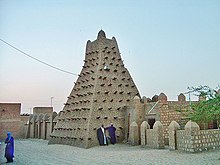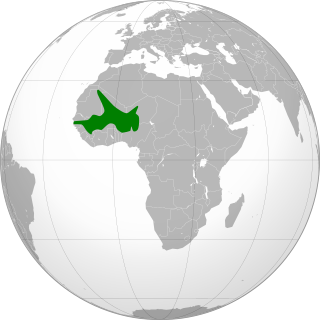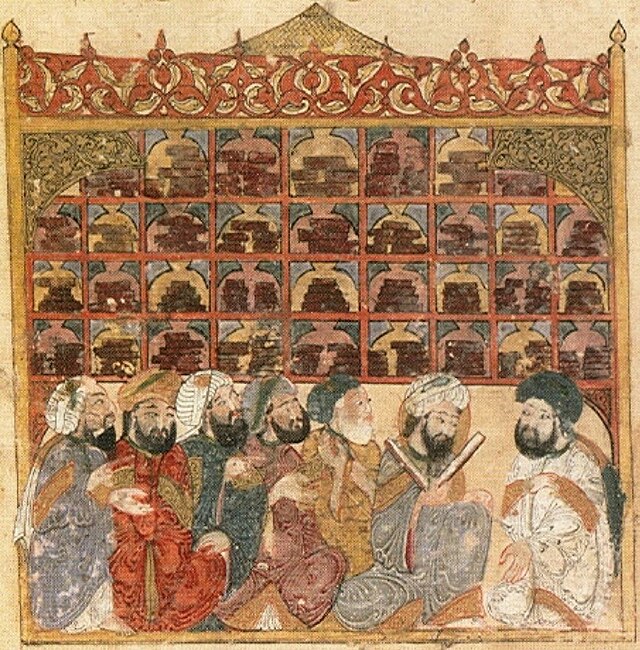Sankoré Madrasah
Ancient center of learning in Timbuktu, Mali From Wikipedia, the free encyclopedia
Ancient center of learning in Timbuktu, Mali From Wikipedia, the free encyclopedia
Sankoré Madrasa (also called the Sankoré Mosque, Sankoré Masjid or University of Sankoré) is one of three medieval mosques and centres of learning located in Timbuktu, Mali, the others being the Djinguereber and Sidi Yahya mosques. Founded in the 14th century,[1] the Sankoré mosque went through multiple periods of patronage and renovation under both the Mali Empire and the Songhai Empire until its decline following the Battle of Tondibi in 1591. The mosque developed into a madrasa (meaning a school or college in Arabic), reaching its peak in the 16th century.[2]
| Sankore Madrasa | |
|---|---|
Médersa de Sankoré | |
 | |
| Religion | |
| Affiliation | Islam |
| Location | |
| Location | Timbuktu, Mali |
| Geographic coordinates | 16.7758876°N 3.0056351°W |
| Architecture | |
| Type | Mosque / Madrasa |
| Style | Sudano-Sahelian architecture |
The term "University of Sankoré" has sometimes been applied to the Sankoré madrasa, though there is no evidence of a centralized teaching institution such as the term university implies.[3] Instead the mosque served as the focal point for individual scholars with their own private students, and as a location in which some lectures and classes were held.[4][5]

The Sankoré mosque was originally built in the 14th-15th centuries with the financial backing of a Tuareg woman of the Aghlal tribe.[6][7] Modern analyzes have rejected the understanding that there was an al-Sahili influence on West African architecture - now treated as a myth - demonstrating that the architectural style of West African mosques derives mainly from mosques in the Sahara and traditional African architecture and religions.[8]
The Sankore Mosque was later restored between 1578 and 1582 AD by Imam Al-Aqib ibn Mahmud ibn Umar, the Chief Qadi (judge) of Timbuktu. Imam al-Aqib demolished the sanctuary and had it rebuilt with the dimensions of the Kaaba in Mecca.[1] The Sankoré madrasa prospered and became a significant place of learning within the Sudanic Muslim world, especially during the 15th and 16th centuries under Askia dynasty of the Songhai Empire (1493–1591).[9] Sankoré was the mosque that was chiefly associated with teaching in Timbuktu in this period.[10]

Timbuktu developed as a commercial centre in the 14th century, as Walata, the previous hub of trans-Saharan trade in the region, began to decline in importance.[11][12] It was not long before ideas as well as merchandise began passing through the city. Muslim scholars associated with the Sankoré mosque accumulated a wealth of books from throughout the Muslim world, leading to Sankoré becoming a centre of learning as well as a centre of worship.[13] At its peak the mosque was the focal point for a class of Islamic scholars that were held in high regard both locally and abroad. Songhai kings would even bestow numerous gifts upon them during Ramadan.[14]
The golden age of the Sankoré madrasa occurred in the 16th century during the Songhai Empire under Askia Muhammad, drawing in scholars from as far as Egypt and Syria. Scholars from Sankoré would also engage in learning or teaching while completing the Hajj to Mecca.[15] The trade in books within the Islamic world was one of the most important aspects of intellectual life in Timbuktu.[16] In 1526 AD the author Leo Africanus noted this trade when he visited Timbuktu, writing: "Here are great store of doctors, judges, priests, and other learned men, that are bountifully maintained at the kings cost and charges. And hither are brought divers manuscripts or written books out of Barbarie, which are sold for more money than any other merchandize."[17] Some Sankoré scholars accumulated large private libraries, with over 1600 manuscripts,[18] though there was no public library or university library in Timbuktu.[13] Manuscripts were copied by local students, giving them a means to earn a living during their studies.[19] Works written in Timbuktu were also exported to North Africa, such as the Nayl al-ibtihaj by Ahmad Baba, a biographical dictionary of Maliki scholars which gained popularity throughout the Maghreb.[20]
In 1591 AD, an invasion by Ahmad al-Mansur of Morocco led to the fall of the Songhai empire following the Battle of Tondibi, starting a long decline of the West African states.[21][22] In 1594 many Sankoré scholars, including Ahmed Baba, were arrested by Moroccan troops on grounds of sedition and deported to Morocco along with their manuscript collections.[23][24]

The integrity of the Sankoré madrasa has been at risk with increased urbanization and contemporary construction in Timbuktu. Significant damage has been done to the mosque due to flooding and a lack of restoration work. As a result, the integrity of the traditional building is at risk. However, there are currently several restoration and protective committees being funded by the government to prevent further damage. The Management and Conservation Committee of the Old Town, in coordination with the World Heritage Center, held long term plans to create a 500 foot buffer zone to protect the madrasa and create a sustainable urban development framework.

As the center of an Islamic scholarly community, the madrasa was very different in organization from European medieval universities, where students studied in one institution and were awarded degrees by the college. In contrast, the Sankoré madrasa had no central administration, student registers, or prescribed course of study. The school instead consisted of individual scholars (known as sheiks or ulama), each with their own private students. Most students learned from a single teacher throughout their entire education, which could last up to 10 years, having a relationship akin to that of an apprenticeship, though some studied at multiple madrasas under a series of teachers. Classes were held either at the mosque or at the teacher's home. While madrasas in other parts of the Islamic world were often funded through endowments known as waqf (charitable giving), students at the Sankoré madrasa had to finance their own tuition with money or bartered goods.[25]
The late 16th-century courtyard was reconstructed to exactly match the dimensions of the Kaaba in Mecca, one of Islam's most holy sites.[25] Classes took place in the open courtyard of the mosque, which was made entirely of clay and wood beams. The building still stands today, likely due to Al-Sahili's directive to incorporate a wooden framework into the mud walls in order to facilitate repairs after the rainy season.[26] Despite its historical significance the Sankoré mosque was smaller and less intricate than earlier Malian mosques such as the Great Mosque of Djenné.[27]

Islamic schooling had existed in West Africa since the 11th century, and although it was usually intended for elites, the Qur’anic emphasis on equality in education allowed for the spread of the institution and increased literacy rates.[28] The Qur'an itself and the hadiths stress the search for knowledge,[28] and Islamic scholarship, especially in the Golden Age of Islam, focused heavily on education.[29] In the 15th century the scholar Al-Kābarī contributed to the development of education in Timbuktu, with a focus on religious teachings.[30] By the 16th century Timbuktu housed as many as 150-180 Qur'anic schools, which taught basic literacy and recitation of the Qur'an, with an estimated 4,000-9,000 students.[31][32] Around 200-300 individuals drawn from wealthy families were able to pursue higher levels of study at the madrasas and attain the status of ulama (scholars).[33] Many of these became influential jurists, historians and theologians in the wider muslim world.[34]
With the Qur'an being the foundation of all teachings, arguments that could not be backed by the Qur'an were inadmissible in discussions and debates at the Sankoré madrasa. Madrasas differed from traditional Qur’anic schools in that they focused on Arabic grammar to properly understand holy texts and Islamic scholarship.[35] However, subjects studied at Sankoré also included mathematics, astronomy and history, drawing from the diverse collections of manuscripts held by scholars. Education at Sankoré and other madrasas in the area had four levels of schooling or "degrees". When graduating from each level, students would receive a turban symbolizing their level.
The first or primary degree (Qur'anic school) required a mastery of Arabic and writing along with complete memorization of the Qur'an.
The secondary degree focused on full immersion in the basic sciences. Students learned grammar, mathematics, geography, history, physics, astronomy, chemistry alongside more advanced learning of the Qur'an. At this level, they learned the hadiths, jurisprudence, and the sciences of spiritual purification according to Islam. Finally, they began an introduction to trade and business ethics. On graduation day, students were given turbans symbolizing divine light, wisdom, knowledge and excellent moral conduct.
The superior degree required students to study under specialized professors and to complete research work. Much of the learning centered on debates regarding philosophic or religious questions. Before graduating from this level, students attached themselves to a Sheik (Islamic teacher) and had to demonstrate a strong character.
The last level of learning at Sankoré or any masjid was the level of judge or professor. These men worked mainly as judges for the city and throughout the region, dispersing learned men to all the principal cities in Mali. A third level student who had impressed his Sheik enough was admitted into a "circle of knowledge" and valued as a truly learned individual and expert in his field. The members of this scholar's club similar to the modern concept of tenured professors. Those who did not leave Timbuktu remained to teach or counsel the leading people of the region on important legal and religious matters. The scholars would receive questions from the region's kings or governors, and distribute them to the third level students as research assignments. After discussing the findings among themselves, the scholars would issue a fatwa on the best way to deal with the problem at hand.
The African civilizations had a rich history in literature and the arts, long before their contact with the Arabian and Western worlds. The scholars employed at the Sankoré university were of the highest quality, "astounding even the most learned men of Islam".[36] As such, many scholars were later inducted as professors at universities in Morocco and Egypt.[37] Scholars were accomplished in multiple disciplines and employed to not only teach the students at the university, but to spread the madrasa's influence to other parts of the Islamic world.[38][27] Under the direction of Askia Daoud, ruler of the Songhai empire from 1549 to 1583, the university grew to encompass 180 facilities and house 25,000 students. Each facility was led by one Ulema, for a total of 180 scholars.
Some significant scholars include Abu Abdallah, Ag Mohammed ibn Utman, Ag Mohammed Ibn Al-Mukhtar An-Nawahi.[39] Most came from wealthy and religious families that were members of the Sufi Qadiriyya. The most influential scholar was Ahmad Baba who served as the final chancellor of Sankoré Madrasa. His life is a brilliant example of the range and depth of West African intellectual activity before colonialism. He was the author of over forty books, with nearly each one having a different theme. He was also one of the first citizens to protest the Moroccan conquest of Timbuktu in 1591. Eventually, he, along with his peer scholars, was imprisoned and exiled to Morocco. This led to the loss of his personal collection of 1600 books, which was one of the richest libraries of his day.[37]
Apart from their time working in their theoretical studies and the preservation of knowledge, the scholars of Timbuktu were extremely pious. Many embarked on the Hajj, the religious pilgrimage to Mecca, and used this opportunity to hold discussions with scholars from other parts of the Muslim world. On the way home, the scholars showed their humble nature by both learning from other leading scholars in Cairo, and volunteering to teach pupils of other schools in Kano, Katsina, and Walata.[37] Mohammed Bagayogo received an honorary doctorate in Cairo on his holy pilgrimage to Mecca.[40]
Seamless Wikipedia browsing. On steroids.
Every time you click a link to Wikipedia, Wiktionary or Wikiquote in your browser's search results, it will show the modern Wikiwand interface.
Wikiwand extension is a five stars, simple, with minimum permission required to keep your browsing private, safe and transparent.